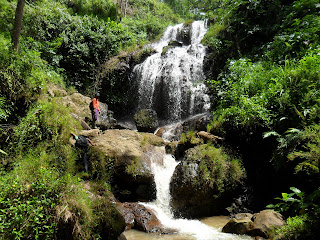Mendut Temple
Mendut is a Buddhist temple. This temple is situated in the village
Mendut, Mungkid district, Magelang regency, Central Java, a few
kilometers from the temple of Borobudur. Mendut founded during the reign
of King Indra of the Syailendra dynasty. In the inscription
Karangtengah 824 AD, stated that the king Indra has built a shrine named
wenuwana which means it is a bamboo forest. By a Dutch archaeologist
named J.G. de Casparis, this word is associated with Mendut.
Decoration found on temple ornaments Mendut be intermittent. Decorated
with carvings of celestial beings and gods gandarwa apsaras or angel,
two monkeys and a garuda. Mendut temple for Buddhists to have meaning.
The presence of three large Buddha statues in this temple has a beauty
that is very high both in physical form or as a work of art. All three
statues of Buddha in the temple chamber is considered still emit rays of
chastity. So among the Buddhist temple is a place of prayer.
Mendut indeed different temples that exist in Indonesia. As a Buddhist
temple, this temple has its own charm. Not only the existence of large
Buddha statue, the temple was also decorated with reliefs depicting
Jataka stories, which are loaded with meaning the teachings of the law
'Cause and Effect.' Reliefs were carved on the outer wing panels ladder
section the bottom.
When it was rediscovered in 1834 AD, the temple was covered with soil
and shrubs. Like Borobudur temple, the temple is expected to also become
victims of the massive eruption of Mount Merapi mahapralaya the year
1006 AD So damaged ravaged affected Merapi volcanic material. And for
centuries this temple is 'drowning' swallowed era, along with the
displacement of the center of the kingdom in Central Java to East Java.
Beside Mendut Temle there Buddhist monastery. This monastery was
formerly a Catholic convent which was then divided up his land to the
people in the 1950s. Then the people's lands are purchased by a
foundation built upon the Buddha and the monastery. In this monastery
there are dormitories, places of worship, parks, and several statues of
Buddha.
Article Source :
http://indonesialand1.blogspot.com/2012/01/mendut-temple.html



















